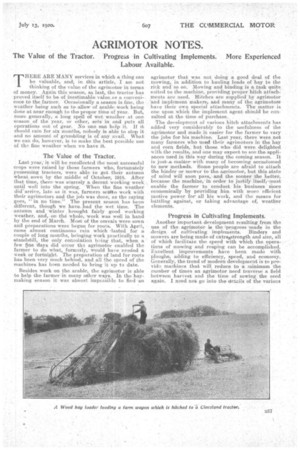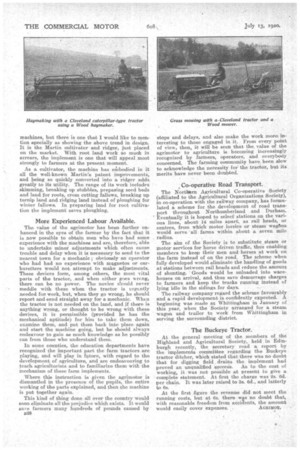AGRIMOTOR NOTES.
Page 25

Page 26

If you've noticed an error in this article please click here to report it so we can fix it.
The Value of the Tractor. Progres in Cultivating Implements. More Experienced Labour Available.
THERE ARE MANY services in which a thing can be valuable, and-, in this article, I am not thinking of the value of the agrimotor in terms of money: Again this season, as last, the tractor has . proved itself to be of inestimable value_ as a convenience to the farmer. Occasionally a season is fine, the weather being such as to-allow of arable work being done at near enough to the proper tirne of year. But, more generally, a long spell of Wet weather at one season of the year, or other, sets. in and puts all operations out of gear. Na one can •help it. If it should rain for six months, nobody is able to stop it and no amount of grumbling is of any avail. What we can do, however, is to make the best possible use of the fine weather when we have it.
The Value of the Tractor.
Last year, it wilLbe recollected the most successful crops were raised by those farmers who, fortunately possessing tractors, were able to get theiir autumn wheat sown by the middle of October, 1918. After that time, there was scarcely a decent working week until well into the spring. When the fine weather did arrive, late as it was, farmers setitto work with their agrimoteTs and the job was done, as the saying goes, "in no time." The present season has been different, though we have had the wet time. The autumn and winter brought fairly • good working weather, and, on the whole, -work was well in hand by the end of March. Most of the cereals were sown and preparations were begun for roots. With April, came almost continuous rain which -lasted for a couple of long months, bringing work practically to a standstill, the only consolation being that, when a few fine days did occur the agrimotor enabled the farmer to do what, formerly, would have needed a week or fortnight. The preparation of land for roots has been very Much behind, and all the speed of the machines has been needed to bring it ue to date.
Besides work on the arable, the agrimotor is able to help the farmer in many other ways. In the haymaking season it was almostimpossible to find an
agrimotor that was not doing a good deal of the .mowing, in addition to hauling loads of hay to the rick and so on. Mowing and binding is a task quite suited to the machine, providing proper hitch attachments are used. Hitches are supplied by agrimotor and implement makers' and many of the agrimotorS have their own special attachments. The matter is one upon which the implement agent should be consulted at the time of purchase..
The development of various hitch attachments has added very considerably to the usefulness of the agrimotor and made it easier for the farmer to vary the jobs for his machine. Last year, there were.not many farmers who used their agrirnotors in the hay and corn fields, but those who did were delighted with the results, and one may expect to see the appliances used in this way during the corning season. It is justea matter with many of becoming accustomed to new methods. Some people are afraid to attach the binder or mower to thei agrirnotor, but this state of mind *ill soon pass, and the sooner the better, because the machine, in order to justify itself i must enable the farmer to conduct his business ' more economically by providing him with more -efficient motive power for all his work, and the means for -battling against, or taking advantage of, weather elements,
Progress in Cultivating Implements.
Another important development resulting from the use of the. agrimotor is the progress -made in the design of cultivating implements. Binders and mowers are being made, of extraAstrength and size, all of which facilitate the speed with which the operations of mowing and reaPing can be accomplished. Excellent improvements have been made with ploughs, adding to efficiency, speed, and economy. Generally, the trend of modern development is to provide machine-8 that will reduce to a: minimum the number of times an agrimotor need traversea field betwe.en harvest and the time of sowing the seed again. I need not go into the 'details of the various machines, but there is one that I would like to mention specially as showing the above trend in design. It is the Martin cultivator and ridger, just placed on the market. With root land work so much in arrears, the implement is one that will appeal most strongly to farmers at the present moment.
As a cultivator, the machine has einbodied in it all the well-known Martin's patent improvements, and being so quickly converted into a, ridger adds. greatly to its utility. The range of its work includes skimming, breaking up stubbles, preparing seed beds and land for roots, cross cutting fallows, breaking up turnip land and ridging land instead of ploughing for winter fellows. In preparing land for root cultivation the implement saves ploughing.
More Experienced Labour Available.
The value of the agrimotor has been further enhanced in the eyes of the farmer by the fact that it is now possible to obtain men who have had some experience with the machines and are, therefore, able to undertake minor adjustments which often cause trouble and delay when it. is necessary to send to the nearest town for a Mechanic; obviously an operator who had had no experience with magnetos or carburetters would not attempt to make adjustments. These devices form, among others, the most vital parts of the tractor, and when either goes ssrcrig, there can be no power. The novice should never meddle with these when the tractor is ergently needed for work, but, when they go wrong, he should report arid send straight away for a mechanic. When the tractor is not needed on the land, and if there is anything wrong, or thought to be wrong with these devices, it is permissible (provided he •lia,s the mechanical aptitude) for him to take them down, examine them, and put them back into place again and start the machine going, but he should always endeavour to gain as much knowledge as he possibly can from those who understand them.
In some counties, the education departments have recognized the important part the farm tractors are playing, and will play in ftiture, with regard to the development of agriculture, and are endeavouring to teach agriculturists and to familiarize them with the mechanism of these farm implements.
Where this instruction is given the agrimotor is dismantled in the presence of the pupils, the entire working of the parts explained, and then the machine is put together again.
This kind of thing done all over the country would soon eliminate all the prejudice whieh exists. It would save farmers many hundreds of pounds caused by
Jas
stops and delays, and also make the work more interesting to those engaged in it. From every point of view, then,, it will be seen that the, value of the agrimotor to agriculture is becoming increasingly recognized by farmers, operators, and everybody coneerned. The farming community have, been slow to acknowledge the necessity for the tractor, but its merits have never been doubted.
Co-operative Road Transport.
The Northern Agricultural Co-operative Society (affiliated to the Agricultural Organizations Society), in co-operation with the railway company, has formulated a scheme for the development of road transport throughout Northumberland and Durham. Eventually it is hoped to select stations on the various lines, about 14 miles apart, as rail heads, or centres, from which motor •lornies or steam wagrais would serve all farms within about a •seven mile radius.
The aim of the Society is to substitute steam or motor services for horse driven traffic, thus enabling members to keep their men and .horses at work on thefarm instead of on the road. The scheme when fully developed would eliminate the handling of goods at stations between rail heads and reduce the amount of shunting. Goods would be unloaded into warehopes on arrival, and, thus save demurrage charges to. farmers and keep the trucks running instead of lying idle in the sidings for days.
The railway company regard the scheme favourably and a. rapid development is confidently expected. A beginning was made at Whittingham in January of this year, when the 'Society arranged for a steam wagon and trailer to work from Whittingham serving the surrounding district.
The Buckeye Tractor.
At the general meeting of the members of the Highland and Agricultural Society, held in Edinburgh recently, the secretary read a report by the implements committee regarding the Buckeye tractor ditcher, which stated that there iva,s no doubt that for digging field drains the implement had proved an unqualified success. As to the cost of working, it was not possible at present to give a complete statement. At first the charge was 2s. 6d. per chain. It was later raised to 3s. 6d., and latterly to 6s. "
At the first figure the revenue did not meet the running costs, but at 6s. there wis no doubt that, with reasonable freedom from accidents, the amount would easily cover expenses. AGRIMOT.




























